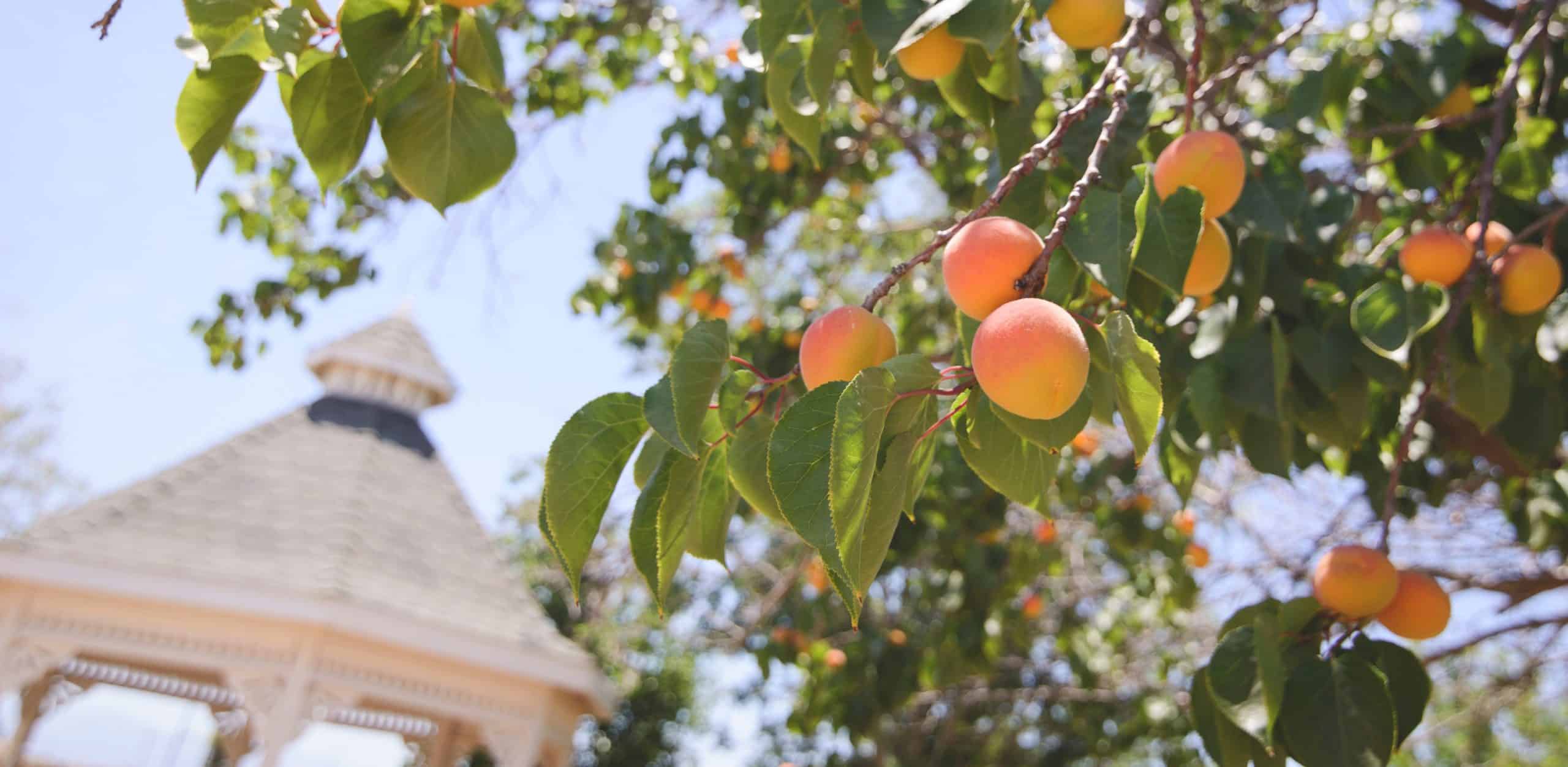
The Top 5 Shed Siding or Exterior Shed Wall Materials
Austin Weaver - November 18, 2024
☃️ Winter Deals You Can’t Miss ☃️
Inventory 3D Builder
When constructing a shed, it can be tricky to choose the right shed siding or exterior shed wall material. There’s a fine line between saving on supply costs and ending up with a cheap building that won’t last with heavy use. That’s especially true if you’re considering prefab storage shed. There are many shed companies producing cheap buildings and selling them on cookie-cutter sales lots. Be wary of any company that doesn’t plainly display the materials used in constructing their sheds.
The truth is…you are putting a lot of money into your new shed and you deserve the information needed to make a good investment.
Quality matters when you are searching for the right siding for shed. Whether you are planning a DIY storage shed project, a brand-new car shed to store your vehicle, or simply an old-fashioned storage shed, what you choose for your shed siding will have repercussions on your dollar investment. You deserve to be fully aware of the options and the benefits of each. With that goal in mind, we’ll take a look at the top 5 shed siding options!
Top 5 Options for Shed Siding (Exterior Shed Wall Material)
1. Vinyl Shed Siding
Vinyl siding is made of polyvinyl chloride (PVC) and comes in a wide variety of colors and textures. Because it is a synthetic product, it offers a customizable look and finish. Vinyl is durable, it won’t be prone to dents or fading. Depending on the brand of vinyl you choose, it should last 30+ years.
If your vinyl shed siding is properly installed it will be long-lasting and able to resist moisture damage. Vinyl doesn’t rot and bugs, including termites, steer clear away. One benefit of vinyl siding is that the color goes deep, beyond just the surface, which keeps scratches undetectable. In consideration of maintenance, vinyl might be the option for you, especially is your looking for little to no maintenance requirements. With vinyl, an occasional rinse with the hose or pressure washer will keep your siding looking pristine.
If you are wanting your shed to be warmer in the winter, vinyl siding can be insulated. Vinyl is also the most DIY-friendly siding. It is typically easier to install vinyl compared to its counterpart, natural wood. Photo: Sheds Unlimited
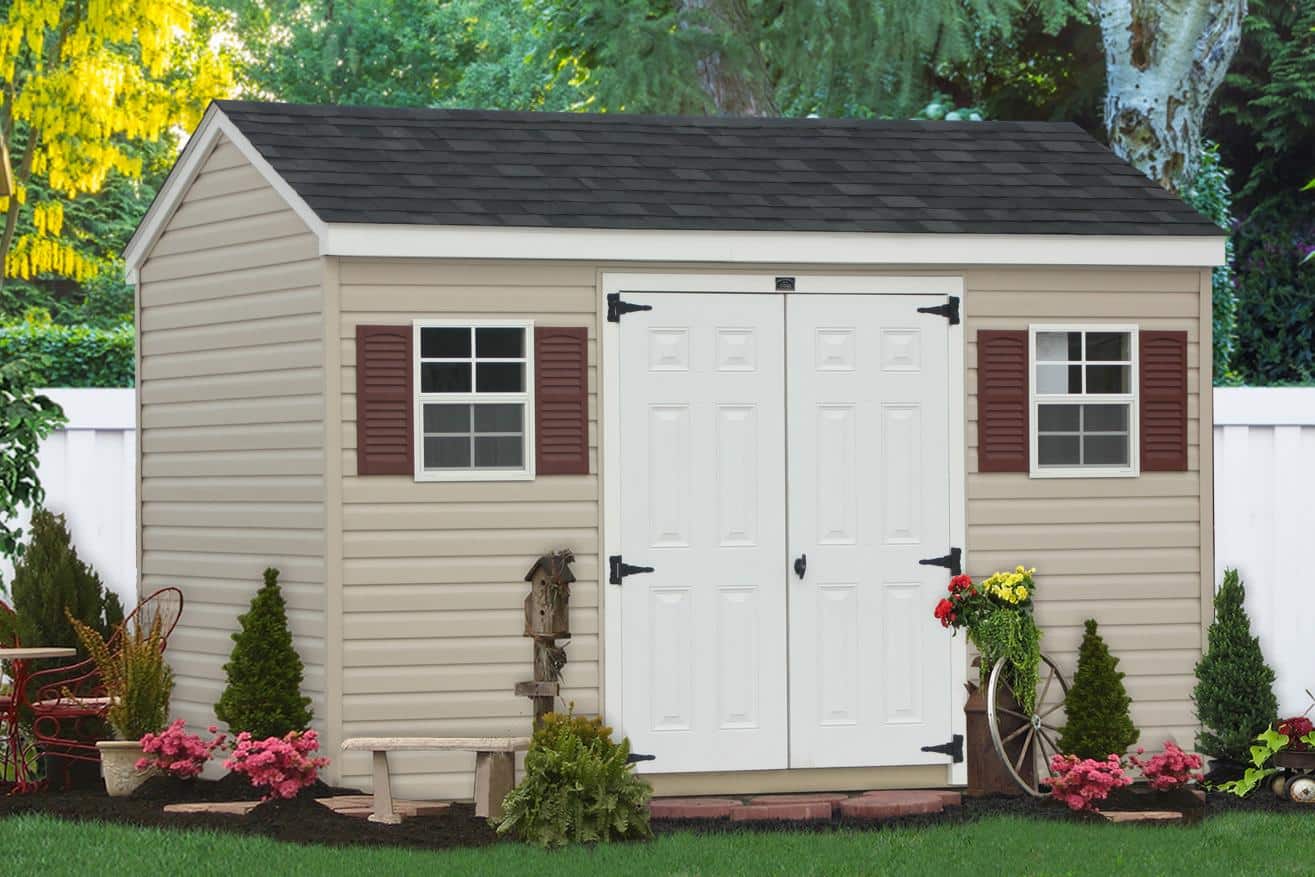
2. Engineered Wood Siding
Engineered wood siding is made up of composite wood – a mixture of fibers and other kinds of wood. It is designed to look like real wood but is more durable. Even though it is not real wood it has an attractive, natural wood look. LP Smartside is one popular and highly recommended brand of engineered wood (it’s also what we use on our sheds). It comes with a 50-year warranty for the wood and comes pre-primed for paint. Engineered wood siding is typically available in 4-foot by 8-foot sheets or lap panels, as well as in smooth or embossed textures.
Engineered wood siding can stand resilient against wood, rot, or termites and resists deterioration. Its impressive durability allows it to withstand incredible amounts of force. Check out this video done by LP Smartside to showcase their material’s incredible impact resistance.
To top it all off, engineered wood is environmentally friendly and easy to install. It is virtually maintenance-free, you just rinse your siding with a power washer to clean the dirt once a year. However, it is important to have the siding installed properly if you wish to avoid some moisture issues. Photo: DuraStor Structures
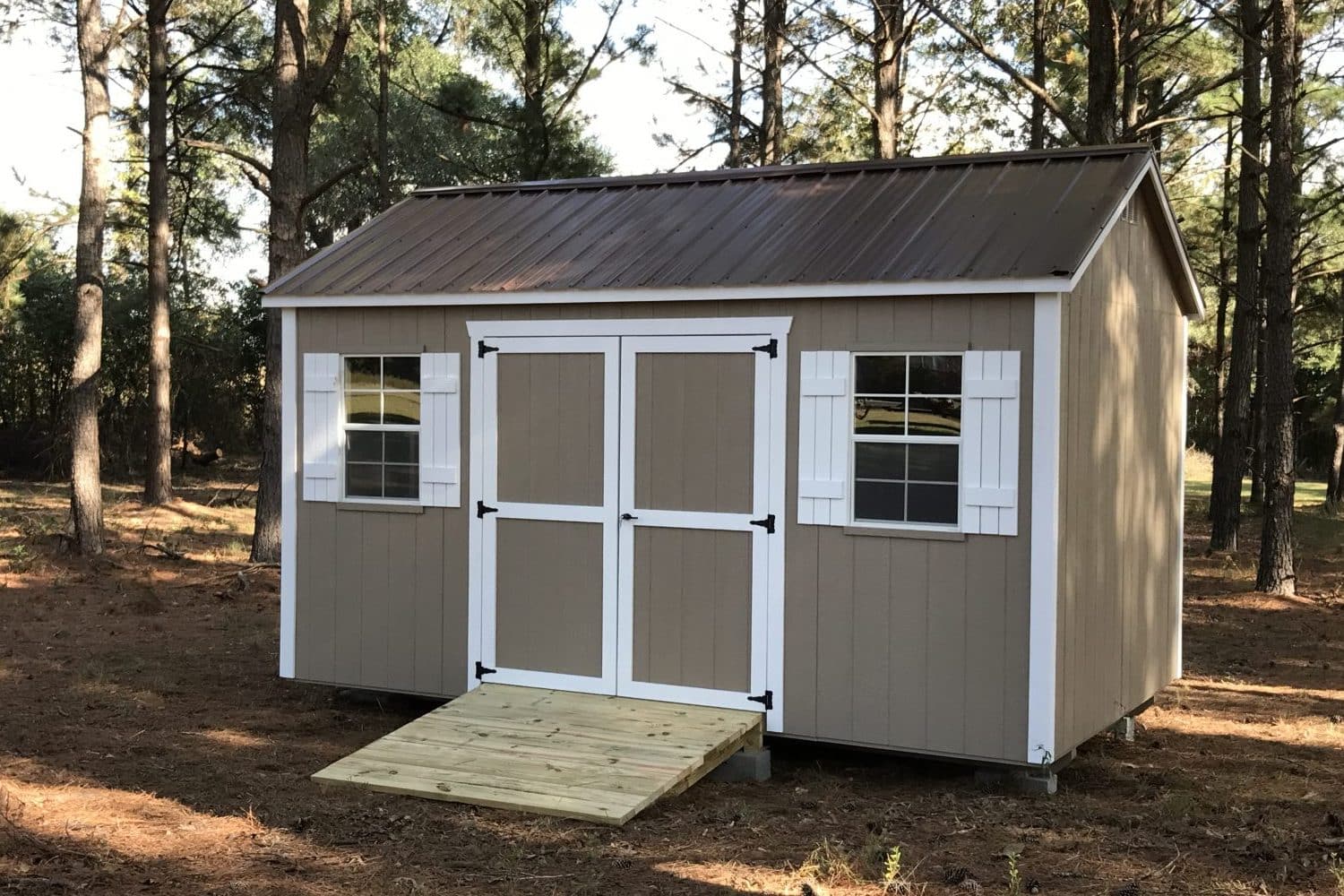
3. T1-11 siding
T1-11 comes in two grades- either plywood or OSB. Plywood is the better quality of the two and the more expensive. OSB (oriented strand board) is basically just chips of wood glued together. OSB is more prone to moisture and, subsequently, rotting. Over a span of time, moisture in OSB can cause your siding to expand and warp. Plywood is the most durable of the two and is considered the most economical and easy siding.
If you are looking for an eco-friendly way to panel your shed, this is the way to go! Because T1-11 siding is a natural material, friendly to the environment.
T1-11 siding adds structural strength to shed walls and, in most cases, shouldn’t dent. Plus, with plywood, no wall sheathing is necessary because they sheath and side at the same time (compared to a siding like vinyl). Generally, plywood is easy to work with but note that it does not come re-primed and tends to have a rougher texture. So, in order to keep it in quality condition, it will require painting or refinishing every 3-5 years to prevent it from rotting or falling prey to fungi and insects.

4. Fiber-cement siding
Fiber cement siding is made from a mixture of cement, sand, and cellulose fiber. These materials are rolled into sheets and pressed to give a pattern. Fiber cement obviously isn’t wood, but its pattern can give a wood grain appearance. It can be made to resemble pretty much any kind of wood.
Fiber cement is durable, and most manufacturers offer a 30+yr. guarantee. This siding is heat, water, fire, and insect resistant. The fiber cement siding also protects the home from wind and rain damage as we as hail.
The cement fiber siding cost is higher than aluminum or vinyl siding. Fiber cement can be difficult to work with so to get the best finished product on your shed, hiring a specialist is the way to go.
5. Metal Siding
Metal shed siding has a much more industrial look than our other four previous options. This choice of siding is environmentally friendly because its material is 67% recyclable. It has a wonderful paint finish, guaranteed to last up to 20-50 years without fading, chalking, or peeling. With metal siding, you don’t have to worry about rotting or twisted boards.
This metal siding is easy to keep clean and requires low maintenance. It is a pest, fire, and weather-resistant. Metal siding is easy to install, and the siding should last up to 50+ years.
Metal siding is becoming a more popular option for siding. Because it is low-maintenance, repels insects, is durable, improves energy efficiency, and gives a stylish and modern appearance.
But it can be tricky when you replace one of the damaged panels. You will have to replace the entire panel in order to fix it. Also, it won’t be easy to install if you have never done it before. We recommend using professionals to install your metal siding.
Photo: Northland Sheds
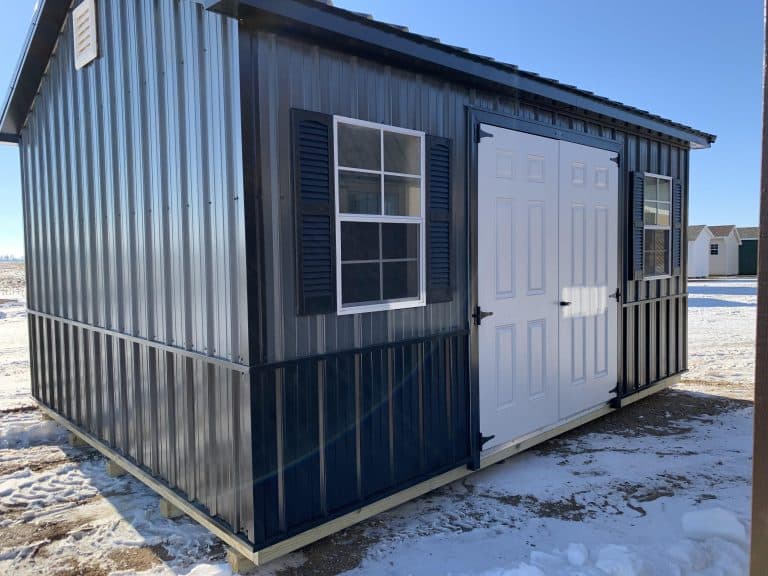
Why Does Your Shed Siding Material Matter?
Let’s take a moment to consider the importance of quality shed siding panels.
Value
With any household investment, you can add value to your property. The possibility of selling your home is in the back of your mind with each new renovation or outdoor addition. Investing in a beautiful, quality shed adds value to your property. Your siding choice will affect the quality and value of your shed which will consequently have an overall effect on your property’s value.
Quality
Not all shed siding options are created equal. There are some cheap selections for siding that might be a quick and inexpensive solution for the moment but will reap a slew of problems not far down the road. Like, rotting, termites, or moisture damage. They say go for “quality vs. quantity”, maybe in this case the saying should go… go for “quality vs. cheap and quickly”.
Maintenance
You already take care of your dog, the neighbor’s cat, and your wonderful grandparents. You don’t need to be babysitting your shed as well. Some shed siding options are high maintenance. Yearly maintenance or even professional maintenance may be required if you wish to keep certain sidings at their best.
Aesthetics
Beauty is in the eye of the beholder, but pretty much all agree that warped or peeling paint is unpleasant to behold. You want to take into consideration the material that you are buying and whether it has poor painting properties. Some siding options, like plywood, have a rough surface, which doesn’t allow for the paint to soak down deep into the material. So, depending on what you wish to coat your shed siding with, you will want to consider the material you are hoping to cover.

Durability
Naturally, you hold your breath when you see the neighborhood children throwing around a baseball in the yard next door, or, even closer, beside your new shed. You might want to consider, “What forces of nature (or objects) are my exterior shed material capable of withstanding”?
Some shed siding options will be better equipped to take a blow from a baseball or to withstand extreme weather elements. You want to invest your money in a siding that will last for years regardless of mother nature or a stray baseball.
In Summary:
Value, quality, maintenance, aesthetics, and durability are significant factors to account for. The material you choose for your shed siding matters and will affect you personally and financially. Now, onto the…
Our Shed Siding Recommendation: Engineered Wood
And the winner is…engineered wood!
At DuraStor Structures, we’ve found engineered wood to be the best exterior shed wall material for two main reasons:
Recommended for Durability
Engineered wood siding holds up to the weather about as well as any other product. LP SmartSide, the engineered wood brand we use on our storage sheds, comes with a 5/50-year warranty. That’s compared to a typical 50-year warranty on vinyl siding, 40-year warranty on metal panels, 30-year warranty on fiber cement and less or nothing on T1-11.
Besides carrying an industry-leading warranty, LP SmartSide withstands impacts better than any other shed wall material (with the possible exception of vinyl). And because it’s designed to be painted, the color choices are much wider than with any of the other products (except T1-11).
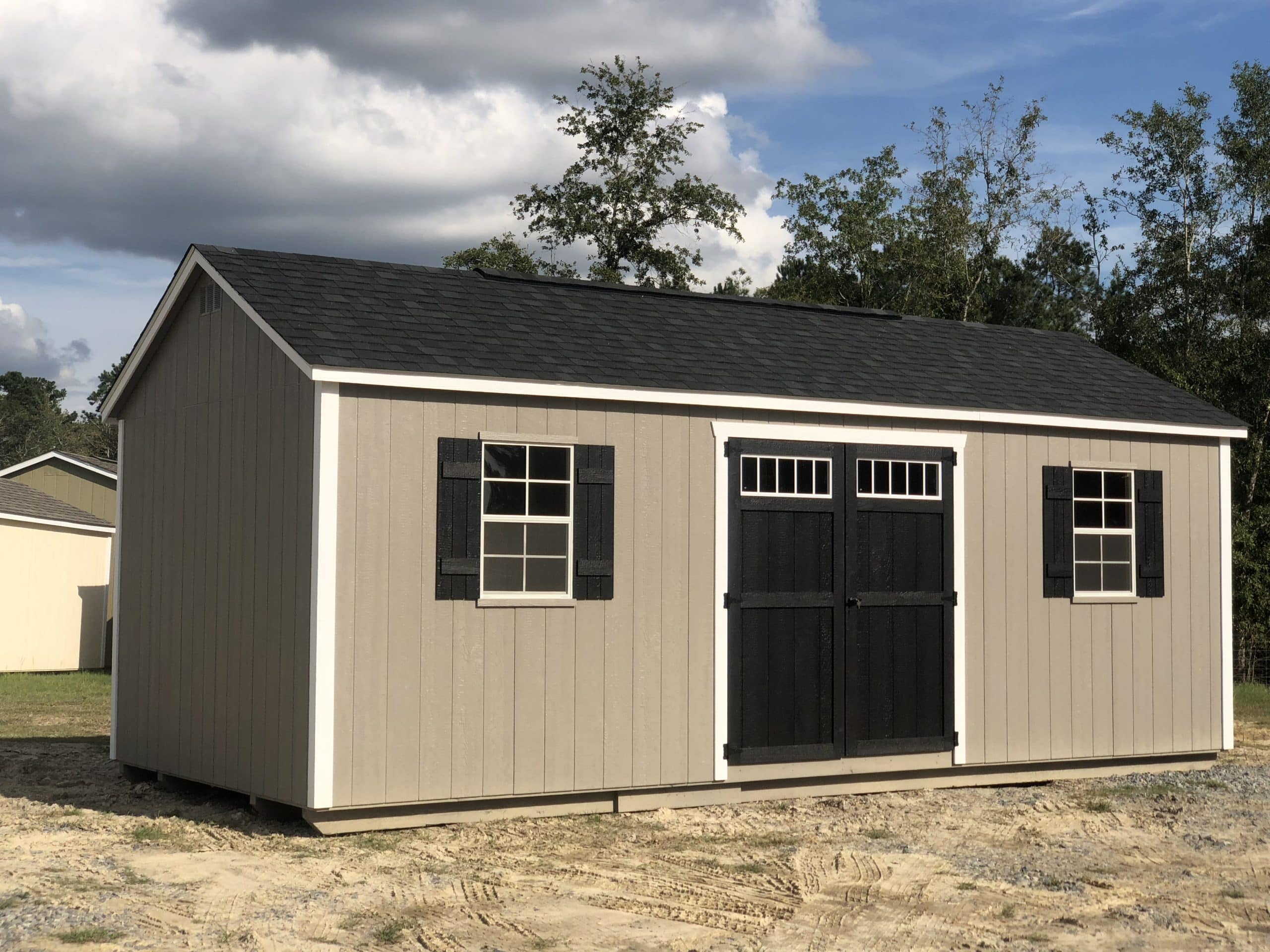
Recommended for Price
All the exterior shed wall materials we listed cost roughly $1.00-$1.50/square foot at a typical home improvement store. However, once extra costs are figured in, like labor or plywood sheathing under vinyl siding, engineered wood really begins to shine. Once total costs are calculated, engineered wood typically costs quite a bit less than both vinyl and metal, the other two products that come close in terms of durability.
So, all things considered, we believe an engineered wood product, like LP SmartSide, is the best choice for exterior shed wall material. If you’re comparing prefab backyard sheds, make sure to check exactly what type of shed siding your builder uses. To see examples of sheds with engineered wood siding, check out the sheds for sale in our inventory!
